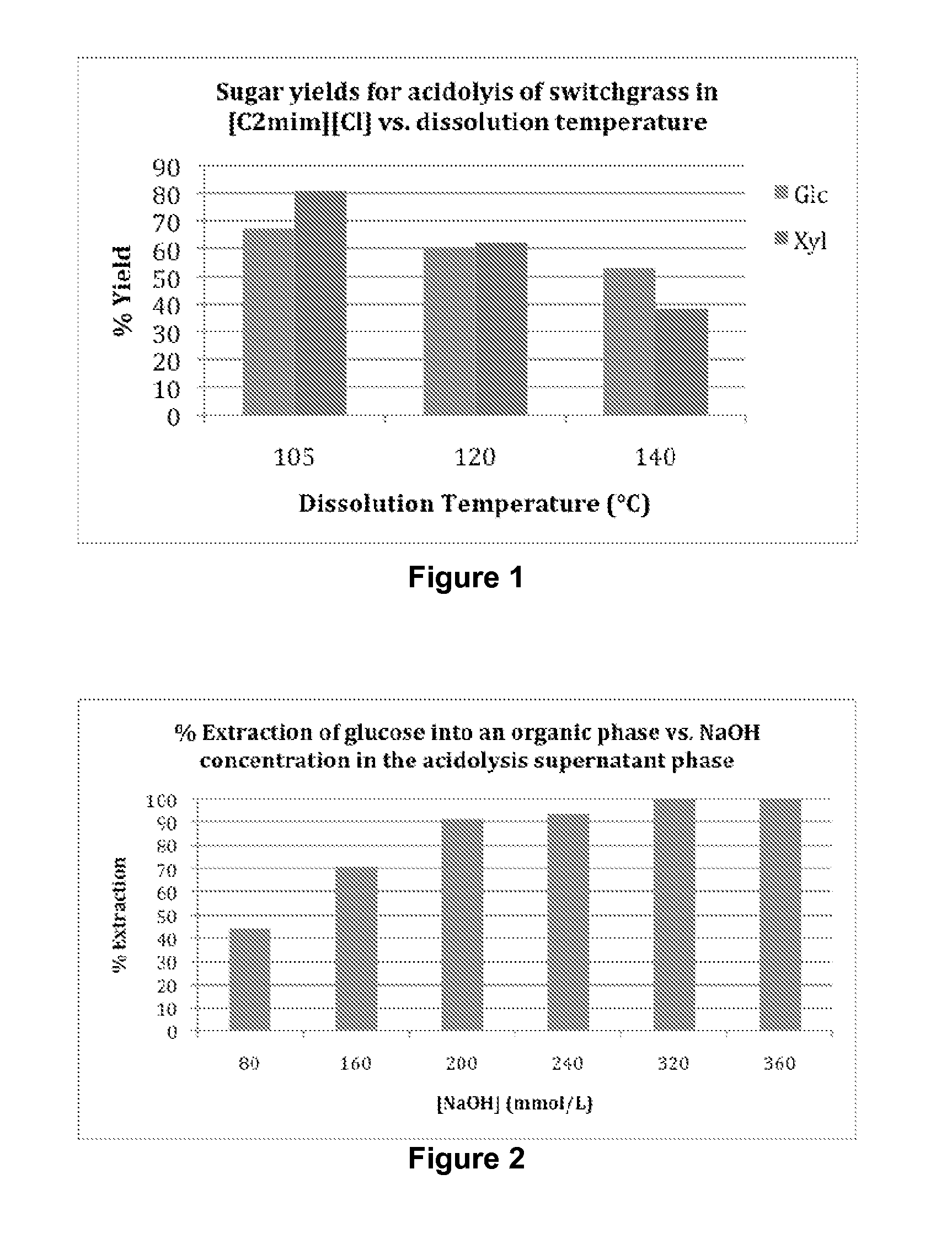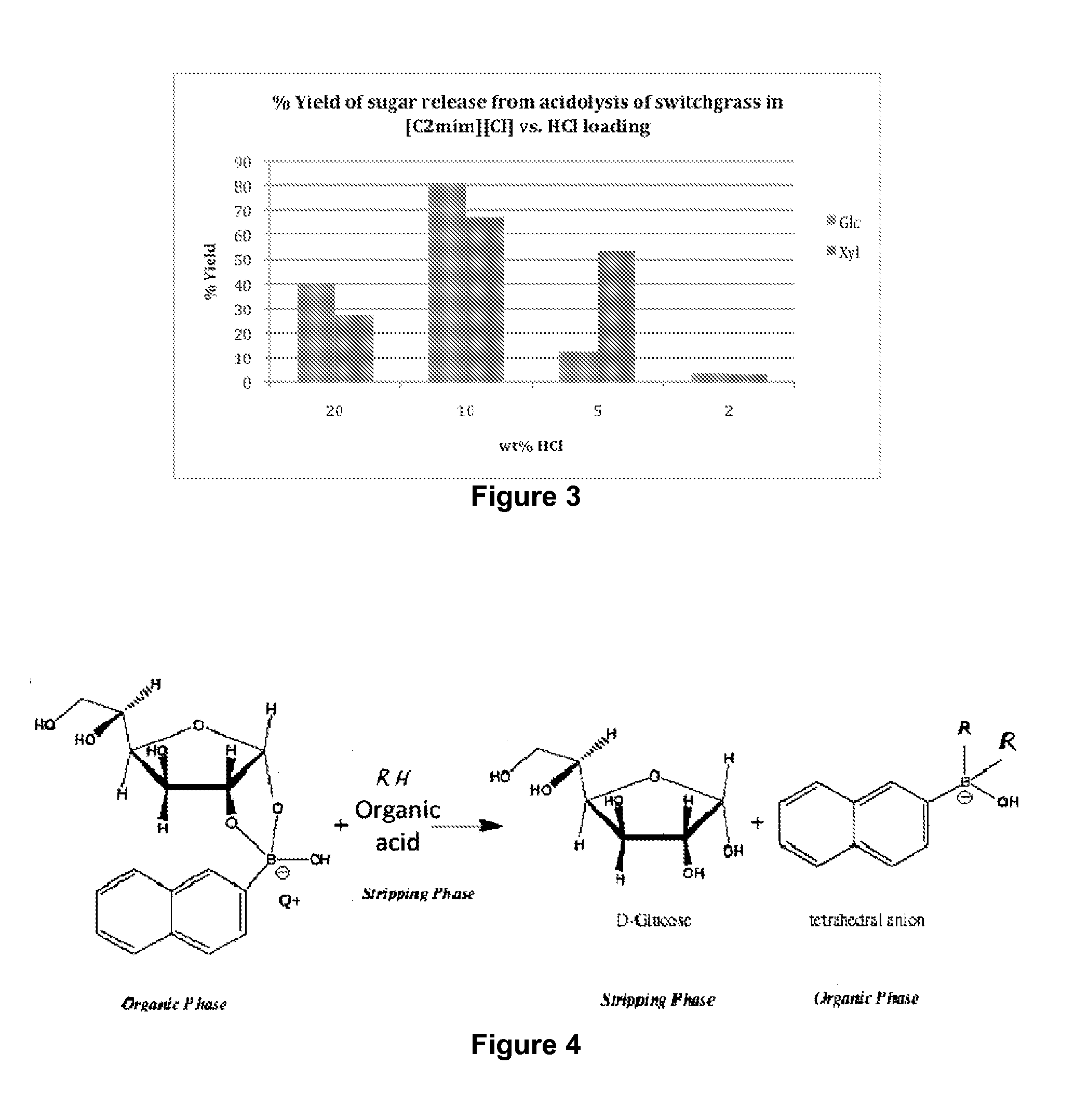Novel method of acid hydrolysis of biomass and the recovery of sugars thereof by solvent extraction
a biomass and solvent extraction technology, applied in the field of biomass saccharification, can solve the problems of difficult recovery and recycling of ils, reduced activity of cellulolytic enzymes in ionic liquids, and high cost associated with il recovery and purification, and achieve the effect of minimizing the formation of sugar dehydration products
- Summary
- Abstract
- Description
- Claims
- Application Information
AI Technical Summary
Benefits of technology
Problems solved by technology
Method used
Image
Examples
example 1
[0062]Corn stover (26.7 mg, 54 mmol glucose units, 44 μmol xylose units) and EMIM Cl (502 mg) are mixed at 105° C. for 6 h. To this mixture is added aqueous HCl (1.66 M, 29 μL, equivalent to 5 mg conc. HCl), and the reaction mixture is stirred vigorously at 105° C. After 10 min, deionized water (100 μL) is added with stirring, followed by additional aliquots at 20 min (50 μL), 30 min (75 μL), and 60 min (125 μL). The insoluble materials can be removed by centrifugation, rinsed twice with water (200 μL), and dried. The liquid products (2.046 g) can be analyzed by HPLC (2.0 mg / g glucose, 42% yield; 2.3 mg / g xylose, 71% yield).
[0063]Optionally, the acidolysis can be performed a second time. The brown solids from the first hydrolysis are heated with EMIM Cl (306 mg) at 105° C. for 4.5 h. To this mixture is added aqueous HCl (1.66 M, 14.5 μL, equivalent to 2.5 mg conc. HCl), and the reaction mixture is vigorously stirred at 105° C. After 10 min, deionized wat...
example 2
Acid Catalysis of Switchgrass in Ionic Liquids with Extraction of Fermentable Sugars
[0065]Ionic liquids (ILs) are of interest as a new solvent for the pretreatment of biomass. The realization of an economically-viable pretreatment technology employing ionic liquids requires the near complete conversion of biomass into its component sugars and recycle of the ionic liquid solvent. The IL 1-butyl-3-methyl imidazolium chloride ([C4mim][Cl]) has been shown to dissolve biomass and subsequently accelerate the rates of enzymatic hydrolysis of holocellulose that is precipitated from biomass dissolved in IL solvents into monomeric sugars. [C4mim][Cl] has also been used to produce sugars in situ using mineral acids such as HCl. Recently, we reported the use of boronic acids to recover sugars from an aqueous-IL phase into an organic phase. The present work employs HCl catalysis of switchgrass dissolved in 1-ethyl-3-methyl imidazolium chloride [C2mim][Cl], and uses naphthalene-2-boronic acid (N2...
PUM
| Property | Measurement | Unit |
|---|---|---|
| Percent by mass | aaaaa | aaaaa |
| Molar density | aaaaa | aaaaa |
| Weight | aaaaa | aaaaa |
Abstract
Description
Claims
Application Information
 Login to View More
Login to View More - R&D
- Intellectual Property
- Life Sciences
- Materials
- Tech Scout
- Unparalleled Data Quality
- Higher Quality Content
- 60% Fewer Hallucinations
Browse by: Latest US Patents, China's latest patents, Technical Efficacy Thesaurus, Application Domain, Technology Topic, Popular Technical Reports.
© 2025 PatSnap. All rights reserved.Legal|Privacy policy|Modern Slavery Act Transparency Statement|Sitemap|About US| Contact US: help@patsnap.com


